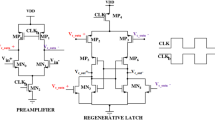Abstract
Schmitt Triggers have found wide spread use in low-power and threshold-based applications such as peak detectors and spectrum analyzers. They are formed by comparators and feedback loops and exhibit hysteresis at nominal supply voltage. When using dynamic comparators, the periodic discharge of internal capacitors prior to each decision process cancels hysteresis. In addition, dynamic comparators produce considerable noise that may affect the operation of hysteresis-based applications. Therefore, currently, Schmitt Triggers are mainly designed as static circuits at the price of less operation speed, more silicon area and higher power consumption compared to their analog counterparts. This paper presents a new low-noise dynamic comparator with programmable hysteresis. Using an advanced comparator structure, as the two-stage dual-clock latch comparator, the hysteresis could be adjusted over more than 30 mV by programming the delay between the two clocks. Moreover, the same delay has been used to reduce the switching noise. The peak kickback noise is then reduced by more than 70%. This has been achieved by designing a customized 4-bit programmable delay circuit. Although several functionalities have been added to the circuit, the proposed design include only a few extra elements with respect to the basic one. As a result, the total consumed energy at 500 MHz is 1.2 pJ/decision only, while the static power consumption is less than 65 pW.






















Similar content being viewed by others
References
Carballo, J. A., Chan, W. T. J., Gargini, P. A., Kahng, A. B., & Nath, S. (2014). ITRS 2.0: Toward a reframing of the Semiconductor Technology Roadmap. In 2014 IEEE 32nd international conference on computer design (ICCD). https://doi.org/10.1109/iccd.2014.6974673
Lotze, N., & Manoli, Y. (2017). Ultra-sub-threshold operation of always-on digital circuits for IoT applications by use of schmitt trigger gates. IEEE Transactions on Circuits and Systems I: Regular Papers, 64(11), 2920. https://doi.org/10.1109/tcsi.2017.2705053.
Bastan, Y., Nejati, A., Radfar, S., Amiri, P., Nasrollah-pour, M., & Hamedi-Hagh, S. (2018). An ultra-low-voltage sub-threshold pseudo-differential CMOS schmitt trigger. In 2018 31st IEEE international system-on-chip conference (SOCC). https://doi.org/10.1109/socc.2018.8618561.
Qian, X., & Teo, T. H. (2009). A low-power comparator with programmable hysteresis level for blood pressure peak detection. In TENCON 2009 IEEE region 10 conference. https://doi.org/10.1109/tencon.2009.5396125.
Lu, J., & Gharpurey, R. (2011). Design and analysis of a self-oscillating class D audio amplifier employing a hysteretic comparator. IEEE Journal of Solid-State Circuits, 46(10), 2336. https://doi.org/10.1109/jssc.2011.2161415.
Lotze, N., & Manoli, Y. (2012). A 62 mV 0.13 μm CMOS standard-cell-based design technique using schmitt-trigger logic. IEEE Journal of Solid-State Circuits, 47(1), 47. https://doi.org/10.1109/jssc.2011.2167777.
Wang, Z., & GuggenbUhl, W. (1989). CMOS current schmitt trigger with fully adjustable hysteresis. Electronics Letters, 25(6), 397. https://doi.org/10.1049/el:19890273.
Rodrigues, C., Neto, D. M., & Muller, C. (2013). Hysteresis settling technique for CMOS comparators based on substrate voltage. Electronics Letters, 49(1), 27. https://doi.org/10.1049/el.2012.3191.
Olumodeji, O. A., & Gottardi, M. (2015). Memristor-based comparator with programmable hysteresis. In 2015 11th conference on Ph.D. research in microelectronics and electronics (PRIME). https://doi.org/10.1109/prime.2015.7251377.
Wang, A., Waters, A., & Shi, C. J. R. (2016). A sub-nW mV-range programmable threshold comparator for near-zero-energy sensing. In 2016 IEEE international symposium on circuits and systems (ISCAS). https://doi.org/10.1109/iscas.2016.7527425.
Nandhasri, K., & Ngarmnil, J. (2000). Hysteresis tunable FGMOS comparator. In ICSE 2000 IEEE international conference on semiconductor electronics. Proceedings (Cat. No.00EX425). https://doi.org/10.1109/smelec.2000.932458.
Carusone, T. C., Johns, D., & Martin, K. (2011). Analog integrated circuit design (2nd ed.). New York: Wiley.
Khanfir, L., & Mouine, J. (2018). Systematic hysteresis analysis for dynamic comparators. Journal of Circuits Systems and Computers,. https://doi.org/10.1142/s0218126619501007.
Khanfir, L., & Mouine, J. (2018) Programmable clock delay for hysteresis adjustment in dynamic comparators. In 2018 30th international conference on microelectronics (ICM). https://doi.org/10.1109/icm.2018.8704067.
Wicht, B., Nirschl, T., & Schmitt-Landsiedel, D. (2004). Yield and speed optimization of a latch-type voltage sense amplifier. IEEE Journal of Solid-State Circuits, 39(7), 1148. https://doi.org/10.1109/jssc.2004.829399.
Rabuske, T., Rabuske, F., Fernandes, J., & Rodrigues, C. (2015). An 8-bit 0.35-V 5.04-fJ/conversion-step SAR ADC with background self-calibration of comparator offset. IEEE Transactions on Very Large Scale Integration (VLSI) Systems, 23(7), 1301. https://doi.org/10.1109/tvlsi.2014.2337236.
Khanfir, L., & Mouine, J. (2018). Design optimisation procedure for digital mismatch compensation in latch comparators. IET Circuits Devices and Systems,. https://doi.org/10.1049/iet-cds.2018.5153.
Maymandi-Nejad, M., & Sachdev, M. (2003). A digitally programmable delay element: Design and analysis. IEEE Transactions on Very Large Scale Integration (VLSI) Systems, 11(5), 871. https://doi.org/10.1109/tvlsi.2003.810787.
Kim, S., & Song, M. (2001). An 8-bit 200 MSPS CMOS A/D converter for analog interface module of TFT-LCD driver. In ISCAS 2001. The 2001 IEEE international symposium on circuits and systems (Cat. No.01CH37196). https://doi.org/10.1109/iscas.2001.921909.
Negut, A., Apostolescu, M., & Manolescu, A. (2009). Switched capacitor hysteresis—Implementation for a programable oscillator. In 2009 international semiconductor conference. https://doi.org/10.1109/smicnd.2009.5336655.
Minaei, S., & Yuce, E. (2011). A simple schmitt trigger circuit with grounded passive elements and its application to square/triangular wave generator. Circuits, Systems, and Signal Processing, 31(3), 877. https://doi.org/10.1007/s00034-011-9373-y.
Kumar, A., & Chaturvedi, B. (2017). Novel electronically controlled current-mode schmitt trigger based on single active element. AEU—International Journal of Electronics and Communications, 82, 160. https://doi.org/10.1016/j.aeue.2017.08.007.
Ranjan, A., Pamu, H., & Tarunkumar, H. (2018). A novel Schmitt trigger and its application using a single four terminal floating nullor (FTFN). Analog Integrated Circuits and Signal Processing, 96(3), 455. https://doi.org/10.1007/s10470-018-1229-y.
Acknowledgements
This publication was supported by the Deanship of Scientific Research at Prince Sattam Bin Abdulaziz University, Alkharj, Saudi Arabia.
Author information
Authors and Affiliations
Corresponding author
Additional information
Publisher's Note
Springer Nature remains neutral with regard to jurisdictional claims in published maps and institutional affiliations.
Rights and permissions
About this article
Cite this article
Khanfir, L., Mouine, J. Clock delay-based design for hysteresis programming and noise reduction in dynamic comparators. Analog Integr Circ Sig Process 106, 409–419 (2021). https://doi.org/10.1007/s10470-020-01656-3
Received:
Revised:
Accepted:
Published:
Issue Date:
DOI: https://doi.org/10.1007/s10470-020-01656-3




